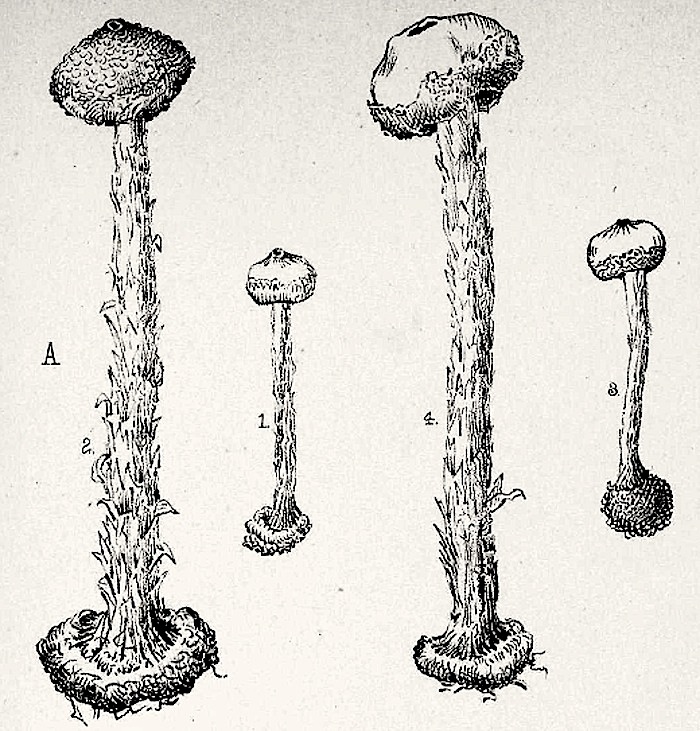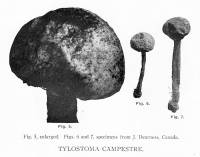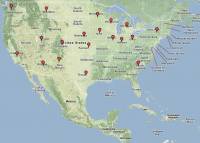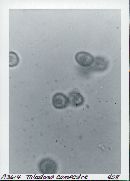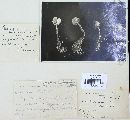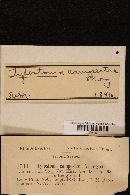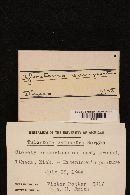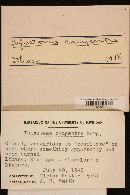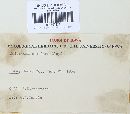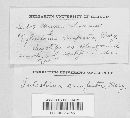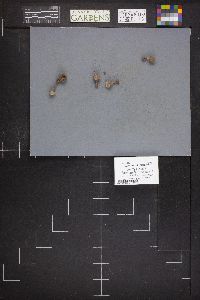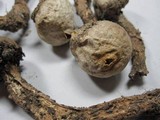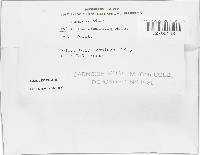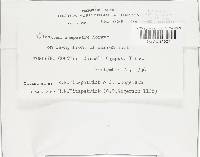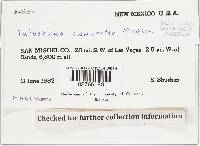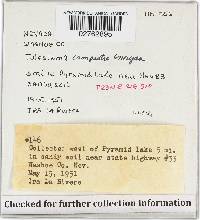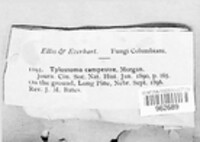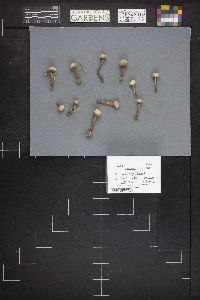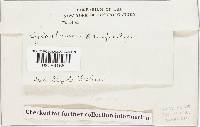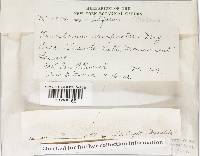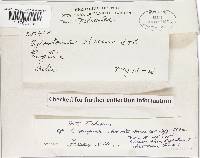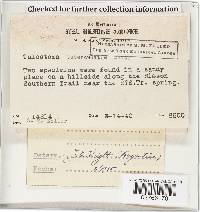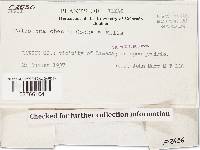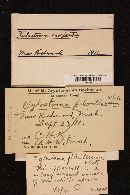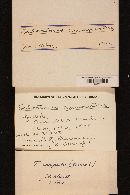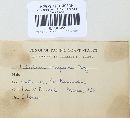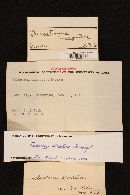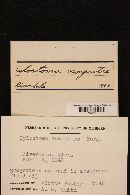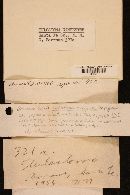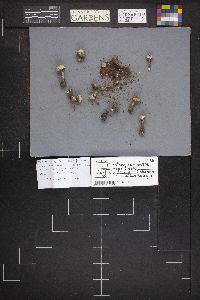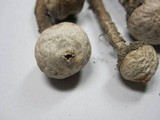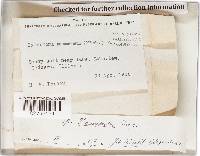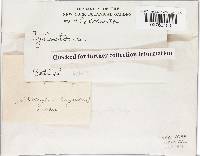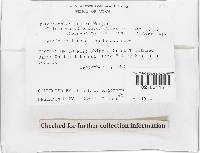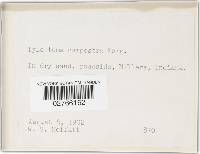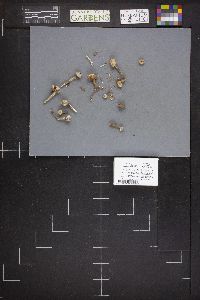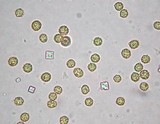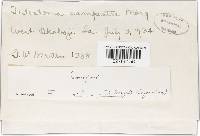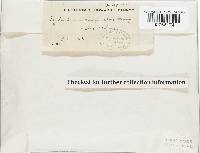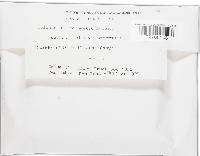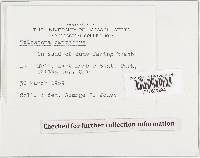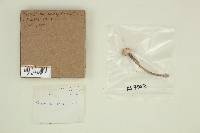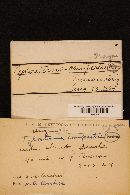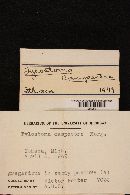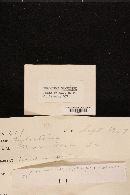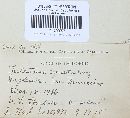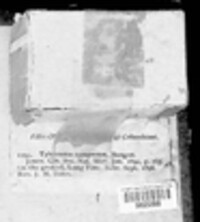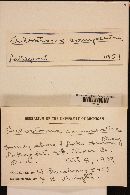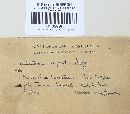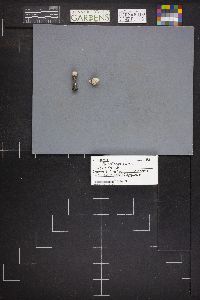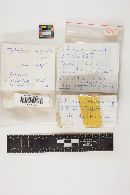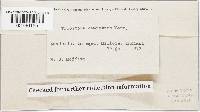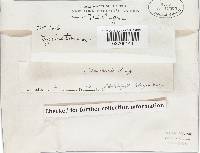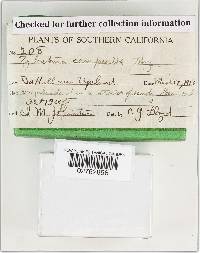
|
|
|
|
Family: Agaricaceae
[Tulostoma campestre Morgan] |
Tylostoma campestre Morgan n. sp.: Morgan, A.P. 1890. North American fungi: third paper. Journal of the Cincinnati Society of Natural History 12: 165.
Peridium depressed-globose, the brown scaly cortex gradually falling away; inner peridium thickish, submembranaceous, becoming smooth and whitish ; mouth plane, irregular, lacerate, not fimbriate. Stipe long, thick, nearly equal, with broad brown scales, white within and fibrillose-stuffed, with a small, irregular, mycelial bulb at the base. Threads of the capillitium long, slender, about as thick as the spores, hyaline, branched; spores irregularly globose, pale brown, very minutely warud, 4.5-5.5 mic. in diameter.
Wright J.E. 1987. Bibliotheca Mycologia 113: 107. Tulostoma fimbriatum Fries var. campestre (Morgan) Moreno (Figs. 54-56; Cls. XIX: 1; XX: 3-6; XLII: 6; XLIII: 1; XLIV: 3). - An. Jardin Bot. Madrid 36: 18. 1980. = T. campestre Morgan, Jour. Cincinnati Soc. Nat. Hist. 12: 163, pl. 16. 1890. = T. granulosum Lév. forma pallida Bres. In Herb. = T. punctilabratum Long, Lloydia 10: 134-135, fig. 18. 1947. = T. karagandense Schwarzmann & Philimonova, Fl. Spor. Rast. Kazhastan, VI: Gasteromycetes, p. 216-218, fig. 77, ab. XII, fig. 9. 1970. = T. kazachstanicum Philimon. & Tart. apud Schwarzmann & Philimonova ibid., p. 237-238, fig. 89, ab. XIV. 1970. = T. granulosum Lév. var. campestre (Morgan)J.E.Wright apud Wright, Herrera & Guzmán, Ciencia (México) 27 (4-5): 116. 1972. = T. costatum Liu, Mycologia 71 (6): 1276-1277. 1979. Etym.: the name of the variety refers to its habitat. Spore-sac globose to globose-depressed, usually between 15 and 25 mm diam, not separated from the stem. Exoperidium typically hyphal, the threads mixed with sand particles and persistent only at the base, ochraceous greyish. Endoperidium thick to parchment-like, smooth or, more generally, with pits or scars of the large sand grains; whitish to ochraceous, isabelline, light greyish brown to cinereous. Mouth typically fimbriate, almost plane to slightly mammose, with a border that may be granulose or, more commonly denticulate, tearing with age and losing many of the former characters. Socket appressed to very conspicuous most times with an entire to denticulate or laceratemembrane, separated from stem. Gleba ochraceous to cinnamon, sometimes ferrugineous. Stem generally stout, subwoody (but fragile in many specimens), 20-100 x 38 mm, the most common size about 50 x 3 mm; straight or, very commonly, somewhat curved, or slightly tapering towards one or both ends, ending basally in a mycelial bulb, sometimes resembling a volva; the most usual colour is light brown or greyish brown, rarely reddish brown; not typically squamose but when scales are present these are rapidly caducous, leaving a silvery surface with 5-8 large ribs which are visible in the upper third of the stem. Spores globose to subglobose, light brown, hardly coloured under L.M., and then verrucose to echinulate, with some of the ornamentations united to form short and irregular cristae; episporium thick, 4.5-8 µm diam, the usual size being 5.5-6.5 µm diam. Under SEM , the ornamentation appears formed by large irregular verrucae, mostly anastomosed, forming a pseudo-reticulum which is of uneven thickness and height. Capillitium subhyaline, septate and branched; threads thick-walled, with visible to solid lumen, and fairly swollen at the abundant, slightly coloured septa; numerous threads are disjointed and remain with blunt ends; 2.4-10 µm diam, usual size being 4-8 µm diam. Habitat: gregarious, sometimes caespitose in sandy soils, generally along river banks, lakes or brooks, under bushy vegetation, or in exposed, desertic zones. Distribution: It is one of the most common members of the genus in North America, being the counterpart of T. fimbriatum Fr. of Europe. It was been found, however, in Southern Europe, particularly Spain and S France, and in other regions of the world. Holotype: It has not been easy to decide which is the holotype of Morgan's species. In his description he cites two collections from: Nebraska, leg. Webber, and from California, leg. Underwood. This rules out a collections in Lloyd's Herbarium, from Preston, Ohio, leg. A.P.Morgan (given as TYPE? in the box at BPI). I am therefore selecting as lectotype a material labelled "Nebraska, leg. Webber, det. A.P.Morgan ex Under-wood, N.A.Fgi" (NY). Illustration: Morgan (loc. cit., pl. 16, fig. 4); White (1901: pl. 23, figs. 10-12); Lloyd (1906, pl. 84, figs. 5-); Coker & Couch (1928, pl. 83). |
|
|
|

